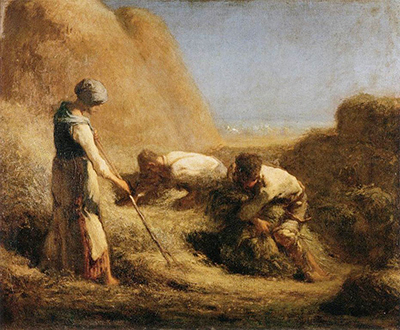Something of a childhood prodigy, Jean Francois Millet's talents – and intelligence – were spotted early in his life, and, presided over by not one but two village priests, the boy being tutored in Latin, art, and modern authors. However, as the eldest son of the large farming family, his education occurred alongside a thorough grounding in the agricultural world from which he sprang. Despite his humble beginnings – which would almost certainly have counted against him – the youth had great success, having his first painting accepted by the Academy when he was just twenty-five or thereabouts.
Most of his artworks, and certainly those that made him famous, all play around the world in which he grew up: agricultural motifs are everywhere, both subtly and overtly. In this painting: 'Les Botteleurs de foin' which translates to 'The Hay-Balers' or 'The Hay-Trussers' both translations of which are used with equal facility by art galleries and afficionados who deal with his works.
Getting the hay harvest in safely was a time of great agitation to farmers in those days. Today, modern machinery can whisk the hay off a field, strip the wheat and bundle the leftover animal feed into neat blocks in mere moments. When Millet was working – both in the fields and on his art – the harvest was a days or even weeks long event which had to be timed for maximum yield, but not left so long as to risk the crop being exposed to heavy rain or hail which would ruin the plants.
The process which today has been streamlined into one action took time. First the harvester would scythe the long grass, gathering it into large bundles, each a comfortable armful. These loads would be placed on the field, left in place in the form of a large haystack to allow the harvester to continue his work. Most of the crop would be protected in the stack from all but the heaviest rain and hail, and yet hay-stacks had other risks if they were left for too long: they could overheat and even spark into fire.
Therefore, once the harvest was complete and the field was dotted about with several large haystacks, the balers would come along. It was their job to gather the long loose grasses, binding it tightly and compressing it into manageable blocks, which could then easily be transported to where the hay was needed – which was almost everywhere in a world run on literal horse power. The compression also served to prevent the decomposition process from turning into a smouldering fire, rendering the crop safe and easily able to be stored in a barn or silo.
Millet manages to capture the balers attention to their work, their urgency driven, perhaps by the haze in the area and the faint suggestion of storm clouds on their way, and yet he goes further. The viewer is left with the impression that the balers are individuals, known to the painter and with fully realised lives of their own. The balers, two women and one man, are recognisable characters, and therein, along with the ability to infuse his otherwise mundane and everyday scenes with golden light and subtle commentary on the lives of the subjects, lies Millet's greatest strengths. The painting, in oil on canvas, is currently in the hands of the Musee du Louvre in Paris.




